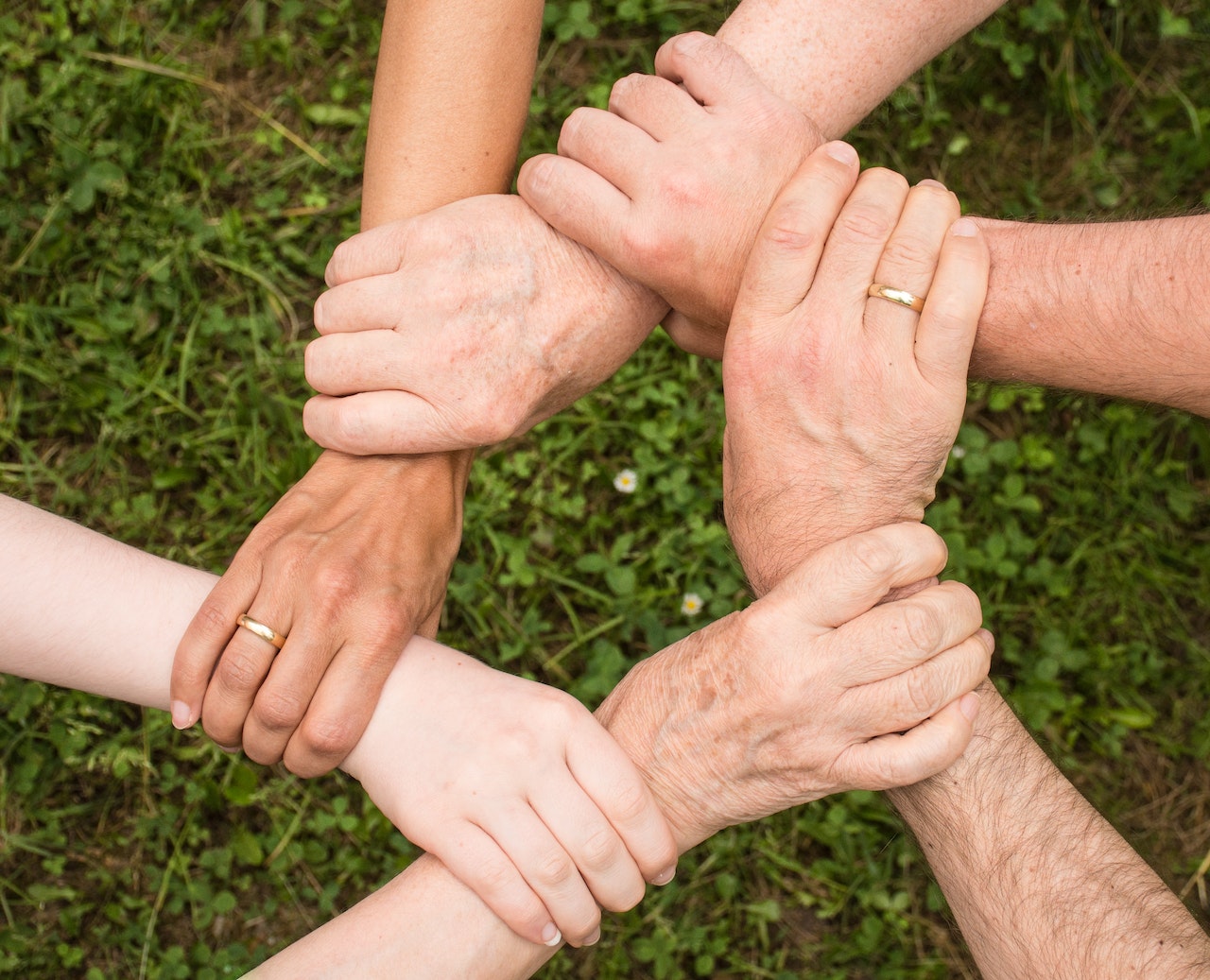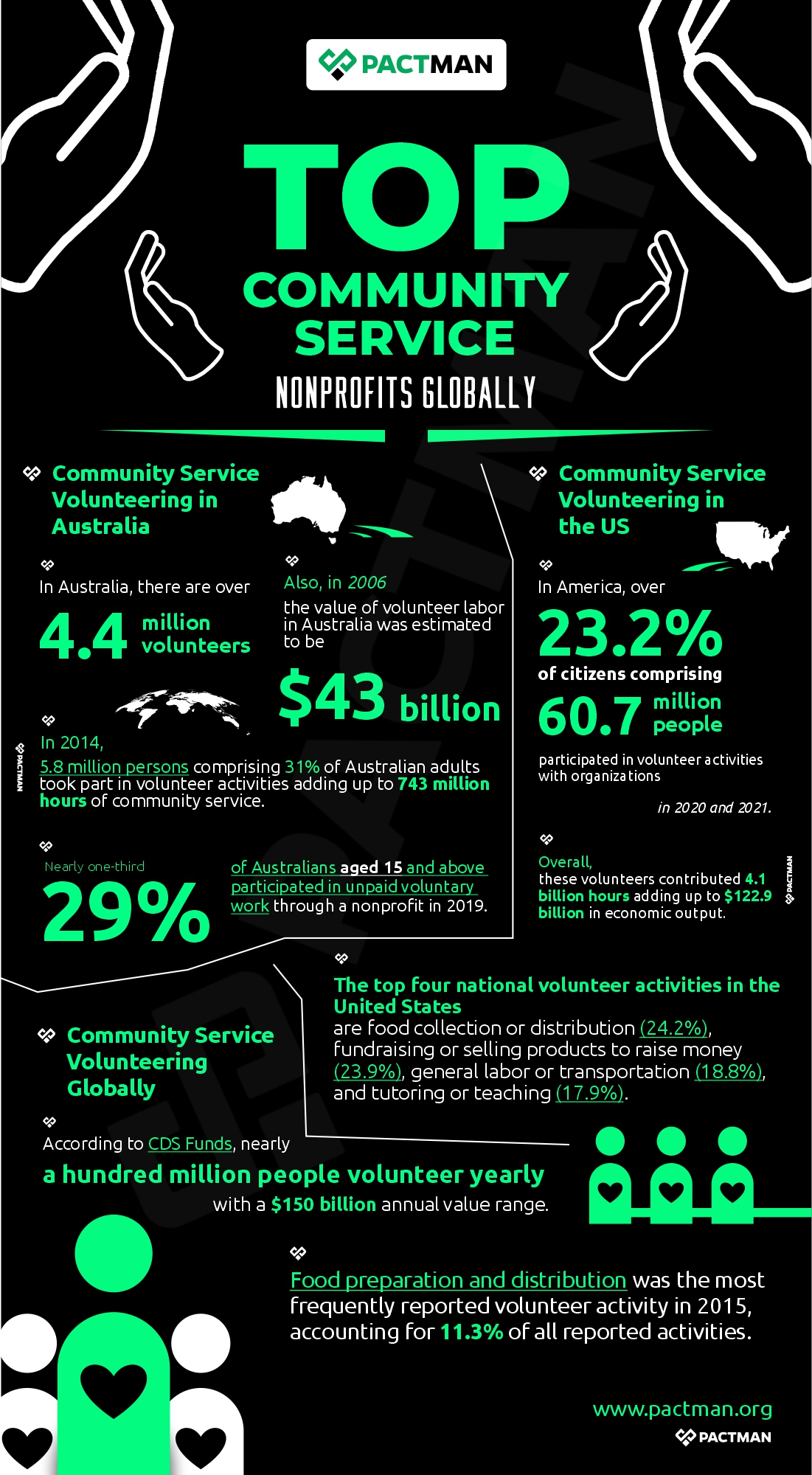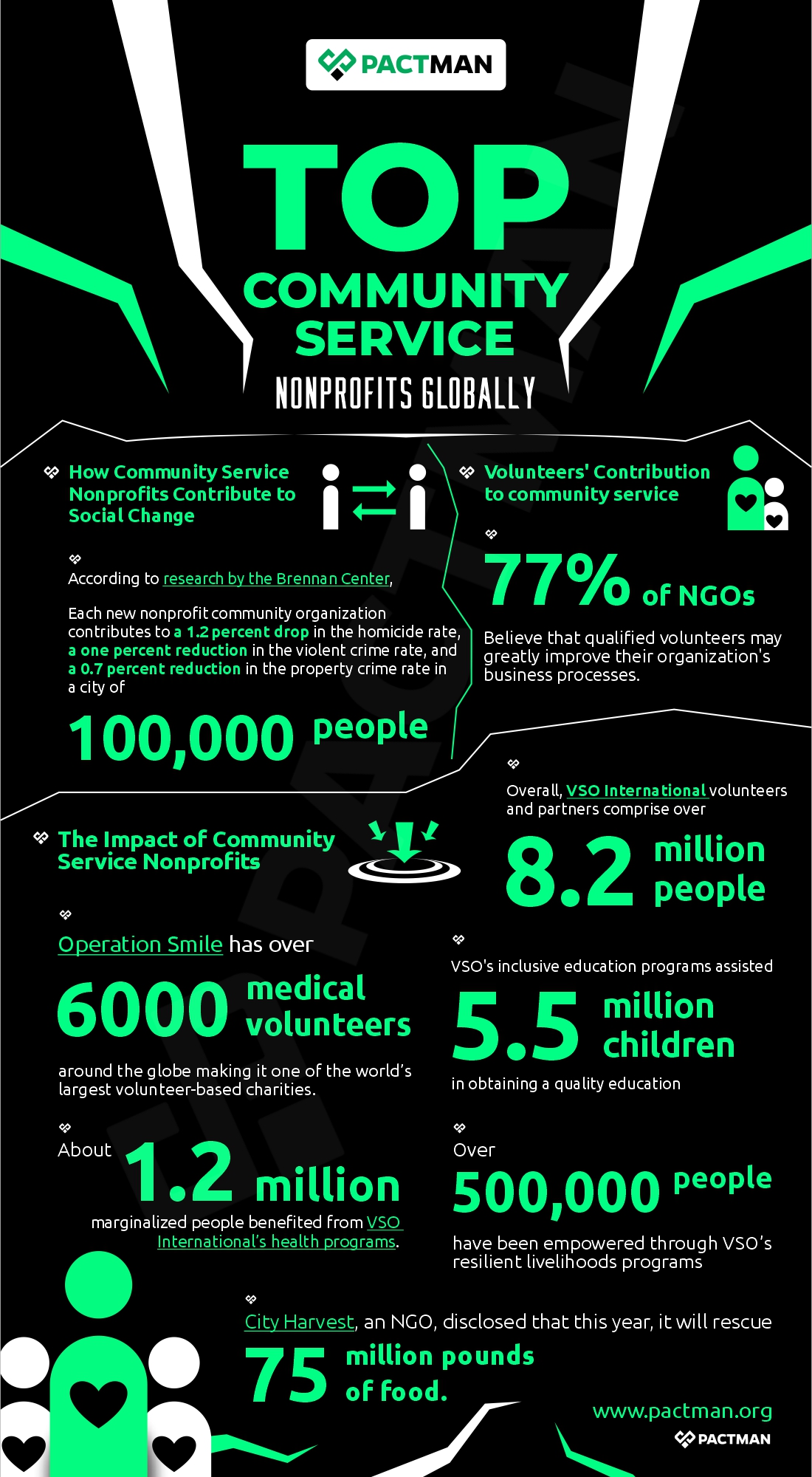I
Introduction
Community service nonprofits provide critical services that contribute to economic stability and mobility. Likewise, these activities help to build and sustain healthy communities. By and large, nonprofit leaders are frequently involved in local groups and politics in order to represent the people they serve. The goal is to cultivate strong community relationships and understand community needs to develop the best method of delivery.

Organizations frequently have strong relationships with the communities they serve on a local level. According to research by the Brennan Center, each new nonprofit community organization contributes to a 1.2 percent drop in the homicide rate, a one percent reduction in the violent crime rate, and a 0.7 percent reduction in the property crime rate in a city of 100,000 people.
Also, for low-income communities that have witnessed a rise in violence, community service NGOs serve as a defense strategy. These entities also provide a safe after-school activity for kids who would otherwise choose less desirable routes. Participating in community service influences future leaders and generations and also benefits the entire community.
II
What is Community Service?
Community service is an astounding combination of labor and compassion that does far more than simply support a deserving cause. In simple terms, it can be defined as voluntary activities that are usually coordinated by an individual or nonprofit within a specific community. Community service can also be defined as unpaid labor done by an individual or group of individuals for no monetary remuneration but to benefit and advance communities.

Oftentimes, community service and volunteerism are used interchangeably. However, they differ in that the former can be considered mandatory employment. Community services assist the general populace. The assistance may take the form of information, advice, practical assistance, financial assistance, or a mix of services.
Also, community services may be provided by federal, state, or municipal governments, as well as NGOs. Similarly, many community services are run entirely by volunteers. In Australia, there are over 4.4 million volunteers.
III
Difference between Community Service and Volunteering
To participate in community service activities, a person does not need to be a member of a certain organization. Also, community service differs from volunteering in that it is not always undertaken voluntarily. The act is conducted by an individual or organization and the goal is to assist or benefit a particular community. Acts can range from a one-time effort to weekly commitment or long-term projects. For the most part, community service is conducted as part of a person’s participation in a social organization.

Volunteering, on the other hand, can be an excellent way for retirees to stay involved in their community. Stay-at-home parents participate in such activities to maintain their professional skills throughout their time away from the workforce. Also, many people volunteer to meet with other people who share their interests, similar to socializing at sporting events. Volunteering broadens people’s networks and professional skills. It also serves as an indication of social cohesion and well-being. Most importantly, volunteering can be used to measure a country’s economic and health status.
The impact on the community is one of the most well-known benefits of volunteering. Unpaid volunteers are frequently the glue that ties a community together. Also, volunteering allows people to become more outwardly focused, which can improve social relationships and even lessen anxiety. To sum up, community service constitutes an integral component of several communities as they rely on the services provided by volunteers.
IV
Community Service Statistics Worth Considering
According to CDS Funds, nearly a hundred million people volunteer yearly with a $150 billion annual value range. Food preparation and distribution was the most frequently reported volunteer activity in 2015, accounting for 11.3% of all reported activities.

In America, over 23.2 percent of citizens comprising 60.7 million people participated in volunteer activities with organizations in 2020 and 2021. Overall, these volunteers contributed 4.1 billion hours adding up to $122.9 billion in economic output. Also, food collection or distribution (24.2%), fundraising or selling products to raise money (23.9%), general labor or transportation (18.8%), and tutoring or teaching (17.9%) are the top four national volunteer activities in the United States.
In addition, there are about 134,253 volunteers working in the US. Women make up 64.0% of all volunteers, while males comprise 36.0%. All things considered, it is without a doubt that nonprofits cannot exist without volunteers.

Also, in 2006, the value of volunteer labor in Australia was estimated to be $43 billion. In 2014, 5.8 million persons comprising 31% of Australian adults took part in volunteer activities adding up to 743 million hours of community service. Nearly one-third (29%) of Australians aged 15 and above participated in unpaid voluntary work through a nonprofit in 2019.
By and large, volunteers allow organizations to save funds while at the same time helping to increase community engagement. They are also effective channels for providing better service to clients. Hence, 77 percent of NGOs believe that qualified volunteers may greatly improve their organization’s business processes.
V
Top Community Service Nonprofits Globally
There are several nonprofits that contribute to community development not just within a specific region but across the globe. These entities seek to further social causes within the global community. Hence, members work together to support an initiative, socialize and exchange ideas that embrace social good.
By and large, community service nonprofits are one of the most significant contributors to community impact. In simple terms, community impact is the intentional improvement of an environment. This could either be by direct behavior change, education, empowerment, or donations. Also, community impact allows individuals or organizations to understand and address issues that are specific to the community.
In view of this, we will consider the top global community service nonprofits and how they work to impact communities spread across different regions.
a. Habitat for Humanity
Habitat for Humanity works to empower individuals in the world’s poorest communities to solve housing issues. The nonprofit seeks to provide the needed support for everyone to have a good home. As a result, the organization strives to discover effective solutions to make available affordable housing.
Also, Habitat for Humanity collaborates with local communities to find available housing solutions because housing issues differ depending on location. Other housing support includes construction, repair, and home renovations. Hence, future homeowners work alongside volunteers and pay a low-interest mortgage.
In addition, Habitat for Humanity helps to make buildings more energy efficient, provide water and sanitation solutions, address disaster issues, and deliver housing loans. The organization also seeks to influence local, national, and international governments including intergovernmental forums to prioritize housing and other housing-related issues.
b. Project Hope
Project Hope is a community service nonprofit that has been working to transform the health and well-being of both people and communities for over 60 years. By and large, the nonprofit seeks to empower local healthcare workers to save lives across the world. Hence, when it comes to world health issues, the organization is always at the forefront of collaborating with communities, healthcare workers, and public health institutions to create long-term change.
Project Hope was established in 1958 as a global health and humanitarian relief organization. The primary goal is to address the most pressing health issues across the globe, to strengthen communities, and to transform lives.
The widespread shortage of healthcare providers continues to be an impediment to the advancement and achievement of global health especially with the rising global population. Hence, Project Hope is working to create a new world that seeks to establish a strong and resilient global community of healthcare workers that are developing creative solutions within communities.
Some of Project Hope’s impacts across countries include training midwives in Sierra Leone, renovating hospitals in Indonesia, and restocking clinics ravaged by natural disasters. The five key areas of emphasis comprise disaster and health crisis; infectious illnesses; communicable diseases; maternity, neonatal, and child health; and health policy. To sum up, all initiatives work toward empowering healthcare workers with the resources to aid the needy.
c. VSO International
VSO International leverages volunteering to effect long-term change. Through working with volunteers and partners, VSO International empowers people in some of the world’s poorest regions. The community service nonprofit works to achieve three goals. The first is to empower poor and marginalized individuals. Secondly, the nonprofit seeks to share the expertise and abilities of volunteers to achieve long-term sustainable change. Lastly, VSO International works to establish collaborative alliances that spur innovation, growth, and influence.
Overall, VSO volunteers and partners comprise over 8.2 million people. The organization’s inclusive education programs assisted 5.5 million children in obtaining a quality education. Also, about 1.2 million marginalized people benefited from VSO International’s health programs. Additionally, over 500,000 people were empowered through VSO’s resilient livelihoods programs in developing the needed skills to live more secure and dignified lives. In conclusion, VSO’s larger work on resilience, inclusion, and social accountability successfully reached over 900,000 people.
d. Operation Smile
Operation Smile has over 6000 medical volunteers around the globe making it one of the world’s largest volunteer-based charities. The organization is dedicated to meeting patients’ cleft care needs throughout their childhood and adolescence to enable them to live healthier and happier lives. The organization’s thousands of volunteers across the world run programs, collaborate with hospitals and run care centers to ensure they provide consistent care to patients.
Overall, Operation Smile’s global movement comprises people from all works of life. The team shares the same vision and passion for patients with cleft issues. According to the organization, anyone born with a cleft issue regardless of location deserves safe, effective, and prompt surgery as well as comprehensive care.
Operation Smile was founded in 1982 and has over four decades of experience as one of the largest surgical volunteer-based nonprofits. On the whole, the staff, its private-public partners, and thousands of volunteers have contributed to improving patients’ health. As a result, people suffering from cleft conditions can breathe better, speak, eat, and enjoy their lives. Other services provided by Operation Smile include surgeries, dental care, psychological assistance, speech therapy, and other critical cleft treatments. Also, the organization’s training and educational programs have assisted in improving local surgical standards and health systems while promoting safe surgery and leveraging its worldwide network to reach more patients.
d. City Harvest
City Harvest was founded forty years ago by a group of New Yorkers who observed that New York City had an abundance of extra food. On the other hand, a large number of its citizens struggled to feed themselves and their families. Presently, City Harvest is the largest food rescue organization in New York City. The organization assists in the feeding of millions of New Yorkers struggling to make ends meet. City Harvest disclosed that this year, it will rescue 75 million pounds of food and deliver it for free to hundreds of food pantries, soup kitchens, and other community partners throughout the five boroughs.
City Harvest collaborates with community partners to increase community capacity, increase nutrition education, and build local food systems. Since its inception, the group has expanded to include 23 food rescue trucks, approximately 190 staff, thousands of volunteers, and a Food Rescue Center. The organization also benefits from the tremendous support of numerous food and financial donors. To date, City Harvest has saved and given over 1 billion pounds of nutritious food to New Yorkers.
e. Direct Relief
Direct Relief works in the United States and around the world to increase access to medicine and healthcare by providing doctors and nurses with lifesaving medical supplies. The organization, due to its years of experience in responding to global issues has devised a number of product solutions that helps to address the needs of vulnerable populations before and after disaster strikes.
Direct Relief is dedicated to delivering items to communities affected by poverty or tragedy. In 2020, the organization received Fast Company’s “World Changing Ideas Award” for its tailored catastrophe response products.
Direct Relief’s humanitarian health activities prioritize the protection of women and children in vulnerable situations. The organization believes that healthy mothers are the foundation of healthy, productive families and communities. As a result, Direct Relief’s activities are focused on protecting women during the vital periods of pregnancy and childbirth. The nonprofit also assists health organizations in countries across the world that provide crucial maternal and neonatal health services during the entire pregnancy, childbirth, and postpartum period.
In addition, Direct Relief’s medical aid programs prepare health practitioners in resource-limited regions to face the challenges of diagnosing, treating, and caring for their patients. Every month, community health centers and clinics order from Direct Relief what they require for low-income, uninsured individuals. The requested supplies are then delivered at no cost by the organization.
f. Partners of the Americas
Partners of the Americas employs a distinct approach of collaboration to deliver transformation initiatives. By bringing together crucial participants such as volunteers, development professionals, governments, corporations, and higher education institutions, the organization is able to match resources, knowledge, and enthusiasm to solve community needs. Basically, Partner of the Americas establishes long-term solutions to the most difficult concerns by connecting local organizations to larger financing possibilities and engaging citizens to become change agents. The organization created in 1964 was inspired by President John F. Kennedy and has worldwide offices in Washington, D.C.
All in all, community service nonprofits are essential to ensuring the community’s growth and development. Their interaction with their surrounding environments allows them to respond more quickly than the government when issues arise. Not to mention, they do not need to wait for a majority vote as they can employ their resources to provide the needed support. Also, one key purpose of these nonprofit groups is to develop a mechanism for promoting individual initiatives for the public good.
Conclusion
Community service comprises the activities and operations an NGO or an individual performs in a community. Each community service organization has different objectives, however, it’s all to address the specific goal of making the world a better place to live. Hence, it is safe to say that community service activities tend to impact a community’s spirit even beyond its outward surrounding. Famine, natural disasters, or a shortage of utilities are just a few of the unforeseeable conditions and circumstances that can have an impact on communities all over the world. To make sure that communities in need receive support, community service NGOs work to establish effective initiatives and solutions. These service opportunities not only make communities and relationships stronger, but they also impact the volunteers themselves. Initiatives such as food drives, mentorship programs, and mission trips all offer rewarding experiences for all parties involved.
Whether we recognize it or not, we all have benefited in one way or the other from the works of nonprofits, most especially community service NGOs. By and large, these entities play a critical role in fostering more egalitarian and prosperous communities.



One Response